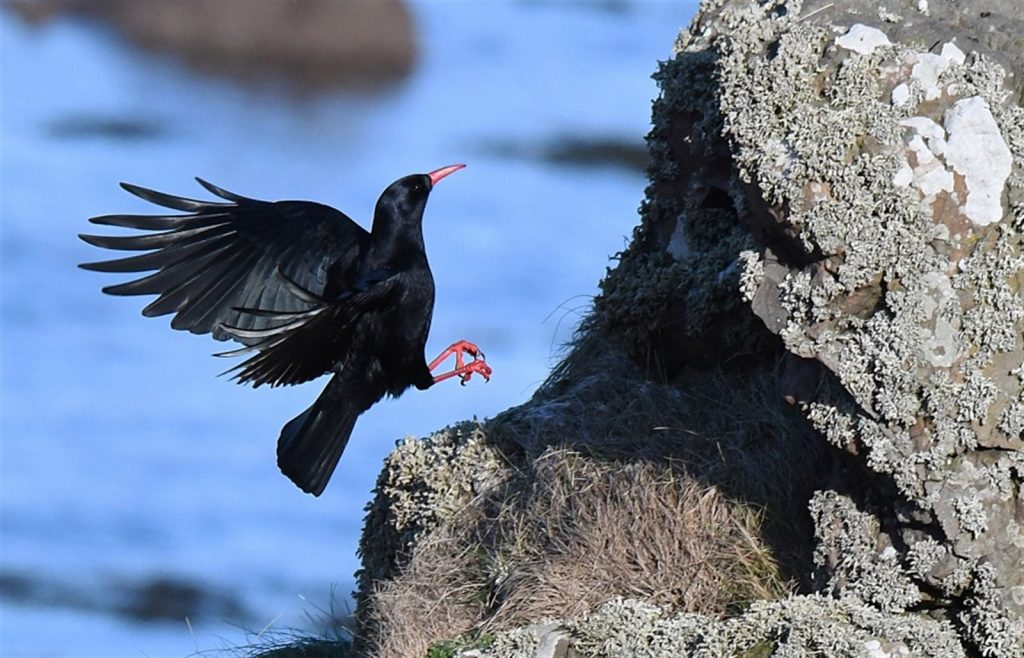The discovery of a Chough just North of Turnberry lighthouse on January 30th 2019 came almost 90 years after the last totally reliable record of the bird in Ayrshire. A once widespread bird in Scotland, the numbers today have declined to the point where it hangs on in places such as Islay, Jura and Colonsay, with all of the former Scottish mainland haunts now unoccupied by breeding pairs.

In South-west Scotland, it would appear that the writing was on the wall from around the middle of the 19th century, when significant declines were noted by the ornithologists of the day. One comment made at the time stated that it had been abundant on all the rocky headlands of Scotland in 1835 but “had vanished nearly everywhere by 1865.” Choughs weren’t restricted to coastal Scotland as is exemplified by records of birds from inland localities such as Assynt, Glen Lyon, Glen Clova and the Ochils. These inland locations had, however, mostly been abandoned by the early 19th century.
In the mid 1800s some coastal cliffs still provided nesting sites for Choughs, and the South-west of Scotland continued to play host to the species. Robert Gray, in 1871, noted that the Chough could still be seen sparingly in the Rhinns of Galloway, along with Burrow Head and the Kikcudbright-Wigtown border. The cliffs around Portpatrick seemed to be a particular stronghold. However, Jack Gordon notes that, by 1870, the bird had vanished from Burrow Head, although it was still to be found on the Rhinns, which appeared to be its “headquarters.”
Within Wigtownshire, nesting pairs were still recorded from locations like Port Logan and the Mull of Galloway until 1919, with an estimate of 7 pairs claimed for the former site. The fate of the Ayrshire coastal birds mirrored that of their Wigtown cousins, since the bird was obviously showing a sharp decline in numbers by the middle of the 1800s. Gray comments that it had still been present at Culzean until at least 1850, but Charles Berry of Lendalfoot paints a gloomier picture. In 1908, he stated that he had seen nesting birds not far from Lendalfoot just a few years before, but that it was fast disappearing.
Gib Graham wrote that the bird had once been “very common” on Knockdolian Hill in the mid 19th century and placed the blame for its decline on the Jackdaw. The 1920s still provided a few Ayrshire records but usually of just one or two birds. Sadly, by 1929, Richmond Paton reported that “one, occasionally two pairs of Chough continue to breed in Ayrshire” – this was at a site which they, wisely, did not name, perhaps providing a clue as to one of the contributory factors in the bird’s disappearance.
So, just why did the Chough disappear from Ayrshire, and much of the rest of Scotland? Like most cases of extinction, the causes may be unclear and much-debated, and it’s often difficult to identify the main culprit. However, some factors do stand out as candidates leading to the Chough’s downfall. The Jackdaw was seen as a potential competitor by many ornithologists in the 19th century. Graham clearly points the finger at it. However, it seems unlikely to have been solely to blame.
For whatever reasons, game-keepers were said to have accounted for some birds, while the gun most definitely did remove birds from areas of the Rhinns of Galloway where Choughs were said by local farmers to be responsible for damage to their crops and “stooks.” It may be that the fashion for bird “collection” and egg-collecting, prevalent in the mid 1800s simply added the final nail in its coffin in areas where the bird’s numbers had dwindled seriously.
Undoubtedly, one of the most serious threats to the Chough came with the rapid changes experienced within farming as we entered the 20th century. Farm boundaries were extended further out, towards the edges of cliffs, removing the availability of rough, grassy swards on which Choughs could probe for invertebrates. Improvements in cattle rearing practices also meant that livestock would frequently be housed indoors now, and not allowed to feed outside in winter, removing yet another food source from the Chough – cow-pats. Probing within cow-pats could provide Choughs with access to parasites, passed through the guts of cattle. But, this source was also to be removed, with the arrival of new chemicals which killed off these “bugs.”
By the end of the 20th century though, Choughs still clung on in areas where the nature of both landscape and land use still afforded them a living: much of Wales, the Isle of Man, North and West Ireland. They are largely sedentary which raises the obvious question of where the Turnberry bird came from. It seems unlikely that Choughs will make a comeback any time soon in the South-west of Scotland, given the pressures they face, and the current Turnberry specimen provides us with yet another clear example of a beautiful bird which, like Corncrake and Corn Bunting in Ayrshire, can disappear all too suddenly from our lives.
Angus Hogg, 7 February 2019